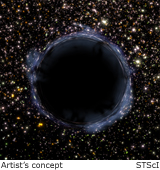Professor

Edward L Robinson

Office: RLM 17.318
Hours: TBA
Phone: (512) 471-3401
email

|
 |
Required Textbooks: None
This is a graduate level course on black holes. The emphasis is on
stellar-mass black holes and, perforce, this means black holes in
binary star systems, but most of the content applies without change to
supermassive black holes in galaxies. By the end of the course
students will have the foundations needed for informed research on the
observational properties of real black holes. At least 2/3 of the
course is an introduction to General Relativity, concentrating on
those aspects of GR relevant to black holes.
The first part of the course is an introduction to interacting binary
stars. We discuss the two body problem, the restricted three body
problem, equipotential surfaces, mass transfer, and end with a brief
discussion of the observational evidence for black holes in X-ray
binary stars. The mathematics in this section serves as a warm-up
exercise for the mathematics needed later in the course and is also
useful for discussing particle trajectories near black holes.
We then embark on a 10-week introduction to General Relativity and
black holes. We concentrate mostly on the Schwarzschild metric with a
few lectures devoted to the Kerr metric. Some specific topics in this
part of the course: A review of special relativity, the meaning of
metrics, geodesics, the Schwarzschild metric in the weak field limit,
the Schwarzschild metric in the strong field limit, Kruskal
coordinates, and the Kerr metric. This part of the course needs
tensor analysis. Since some students may not know tensor analysis and
many will need a refresher, the course introduces the required
mathematics, so no previous course in tensor analysis is really
needed.
The final few weeks of the course will be devoted to a special topic,
which varies from year to year. Possible topics are gravitational
radiation, accretion disks, or computation of geodesics.
The course grade will be based on homeworks, a mid-term exam, and a
final exam, weighted 1/3 each.
|

